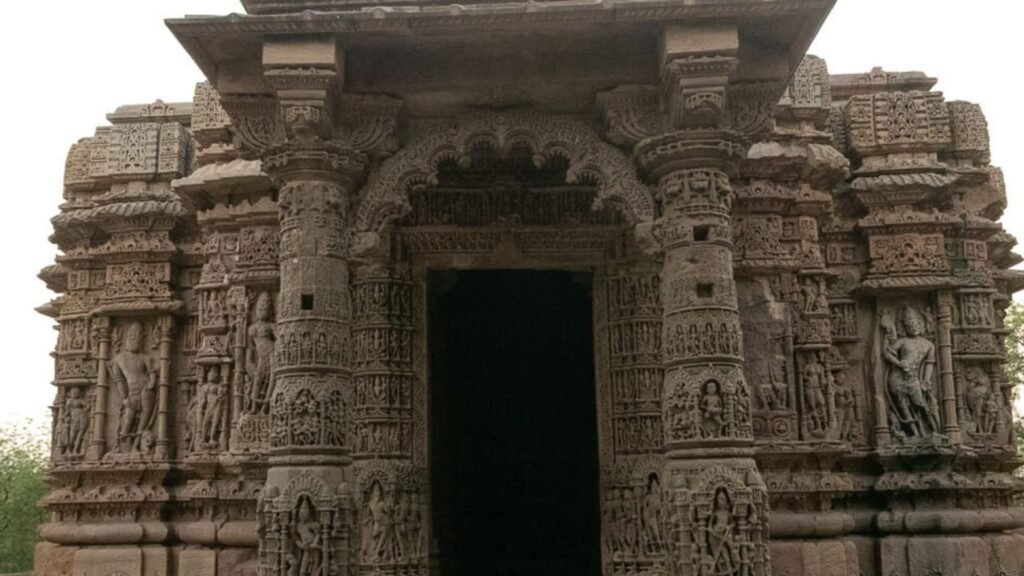Here’s the Modhera Sun Temple travelogue written by traveller Jayanthi Chandrasekaran. Read about her amazing experience at the Modhera Sun Temple!

As I entered the complex of the Sun temple in Modhera (situated in the Mehsana district in Gujarat), the first sight of the temple facing the pushkarni was spellbinding, to say the least. I can only imagine the reaction of Colonel Monier-Williams, the surveyor general in 1809, when he set his eyes first on this temple. He describes in his journal that ‘the structure is one of the finest specimens of Hindu architecture I ever saw…ornamented so profusely that it is very evident the founder was determined to make it the most finished piece of work that it was possible for the compass of human art to effect’.
Through the evidence of inscriptions, it has been assessed that King Bhima I of the Chalukya dynasty built the Modhera Sun temple during 1024-24 CE. It is strategically situated at 23.6 degrees latitude very close to the Tropic of Cancer so that the first rays of the sun hit the idol on the day of the solar equinox. The entire complex was built with red-brown sandstone through dry masonry methods without any mortar joining the stones.
The architectural layout of the temple consists of three distinctive parts, namely the main shrine consisting of Garbagriha and a pavilion known as Gudhamantap, an entry hall referred to as Sabhamantap, and the temple tank, Ram Kund. The tank itself is a marvel with its geometrically aligned steps and housing numerous small shrines. As per legend, stepping out of the Kund and ascending the steps of the Sabha mandap symbolises the spiritual journey from mortality to enlightenment.

The entrance to the Sabhamantap from the steps ascending from the Kund is through Kirti-torana, the triumphant arch, of which only the two decorative pillars on both sides remain. This assembly hall is an architectural parallelogram giving the impression of a star-like structure. As you enter this assembly hall, the sight of 52 intricately carved pillars takes your breath away. The Sabhamantap has entrances on all four sides. Truly a photographer’s delight, one has to put up with the tourists going crazy clicking away from all sides with myriad poses. The pillars breathe life into the mythological tales, depicting scenes from Ramayana, Mahabharata and Krishna Leela through meticulously sculpted figures etched on them. The pillars hold up ornate arches and in between lie magnificent ceilings. The grandeur of the pillars is a testament to the architectural prowess of the masterly hands of yore.

To the west of the Sabhamantap stands the Gudhamantap enclosing the main shrine (Garbagriha) where the primary deity Lord Surya must have been housed. Alas, it stands sealed now with no deity. The ingenious design of the mandap would have enabled the first rays of the Sun to bathe the deity in its glow during the equinox. There is a circumambulatory path around the empty shrine.

The interiors of the Gudhamandap are not decorated except for a few carved sculptures of the Sun God on his chariot, but the outer walls more than make up with their carved brilliance. The base of the structure is in the form of an inverted lotus, above which elephant carvings are seen, known as ‘gajathara’ signifying strength and power. Above this are carved ‘narathara’ which has figures of people at different phases of the life cycle from the birthing scene and various stages ending with a carving of death where the person is taken for cremation. The intricate decorations of the outer walls also include Lord Surya in various forms apart from other Gods like Ganeshji, Saraswati, and Agni to mention a few.
Today the temple stands as a testament to the creativity, patience, perseverance and hard work of the artisans, all of which merge to create this beguiling masterpiece. Their eternal tribute to the Sun God speaks out its own language carved on stone, which simply surpasses any spoken dialect.
ALSO READ: The Sacred Ensembles of Hoysalas
